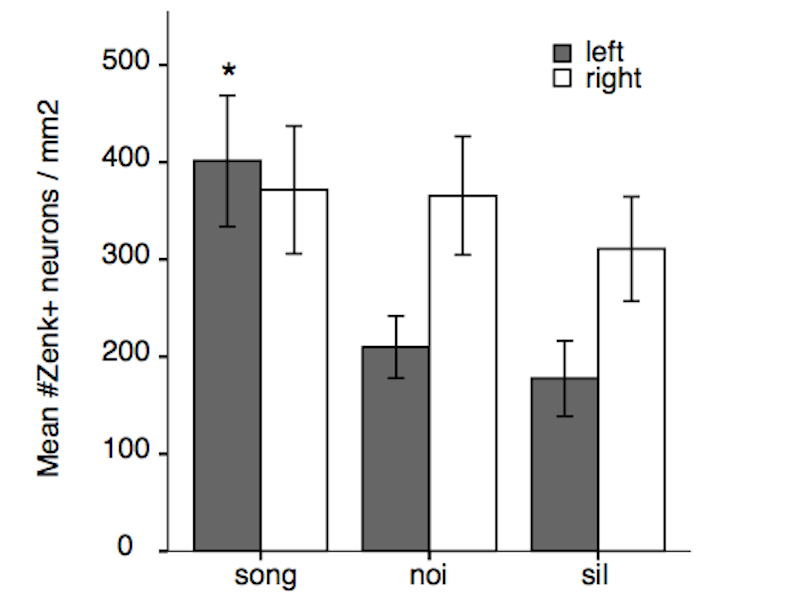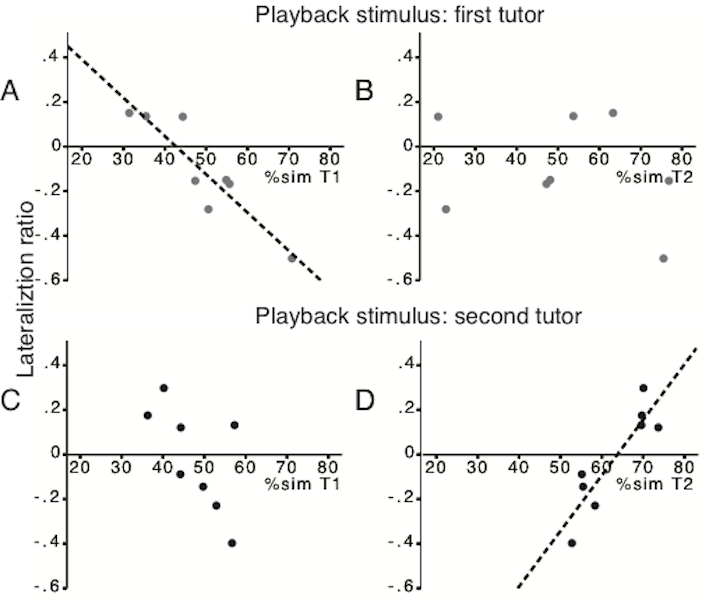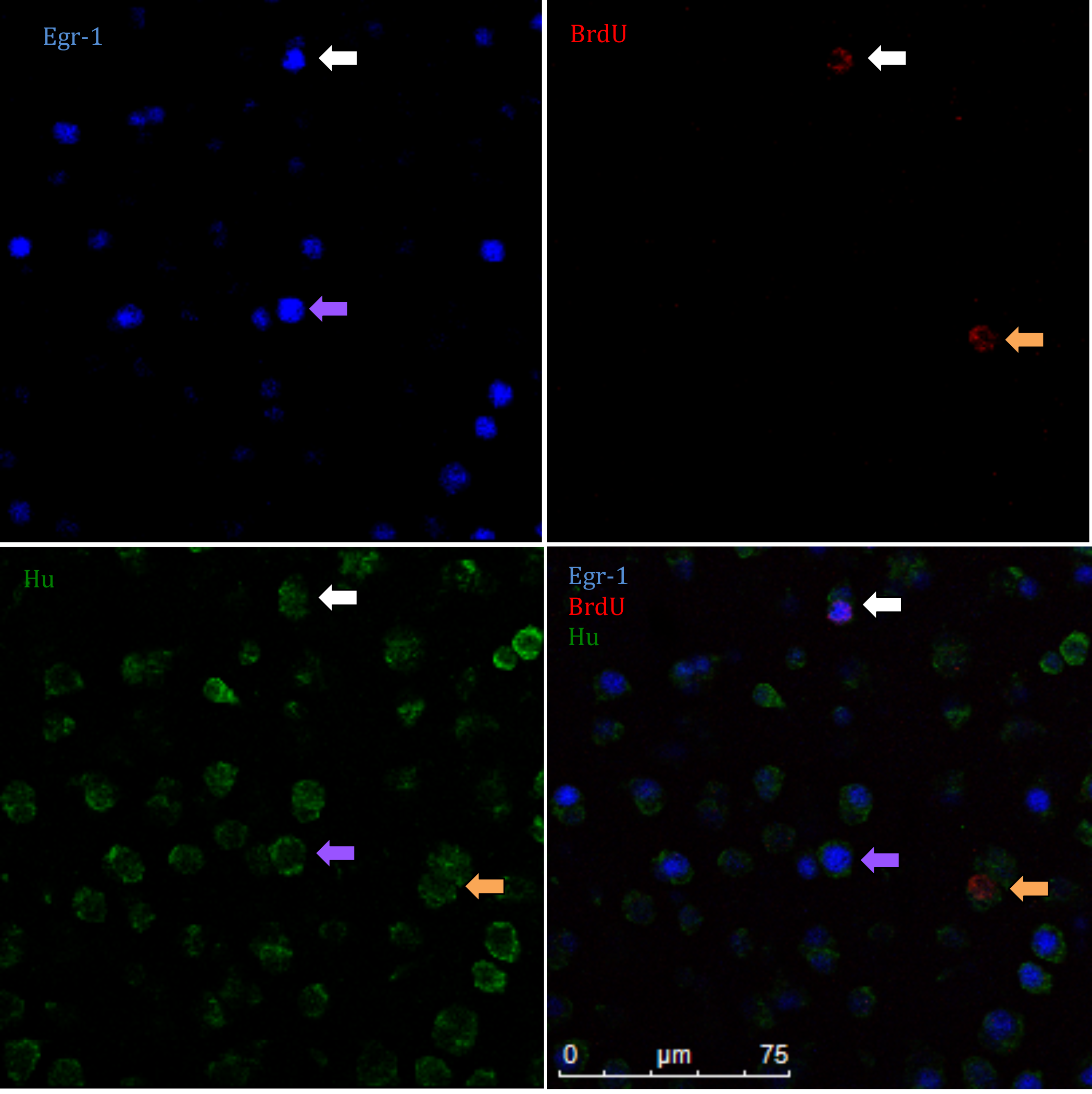Neurogenesis
As in humans, the neural substrate for song memory seems to be left-dominant
in birds that are already imitating (parts of) their tutor's song (Moorman et al.
2012, 2015). To investigate whether left-hemispheric dominance is innate, students
in the lab have investigated lateralization of the NCM at the onset of learning by
using the expression of Immediate Early Genes as a marker for neuronal activation.
When zebra finches are first exposed to a conspecific song, there is no left-dominance
yet in their neuronal response (Fig. 1; Chirathivat et al. 2015). However, even in birds
that have never heard a song before, the NCM in the left hemisphere distinguishes
between song and a rhythmic white-noise stimulus that resembles song, whereas the NCM
in the right hemisphere does not (Fig. 1; Chirathivat et al. 2015). Thus, the left NCM
seems to have a predisposition for song perception and, potentially, for learning.

To investigate how lateralization of the NCM contributes to learning not one, but two
songs during development, male zebra finches were sequentially exposed to two different
song tutors. At adulthood, zebra finches were exposed to either the song of their first or
their second tutor, in order to induce Zenk expression. Neurons activated by re-exposure to
these songs may be (part of) the neuronal representation of the first or second tutor song.
In the NCM, we found that there was proficiency-dependent lateralization of first and second
tutor song (Fig. 2; Olson et al. 2016). Birds who were more similar to the first tutor
at adulthood showed greater right lateralization in response to the song of the first tutor,
whereas finches who were more similar to the second tutor at adulthood showed greater left
lateralization in response to the song of the second tutor (Fig. 2; Olson et al. 2016).
Therefore, the left NCM may hold the memory for the more recent, behaviorally relevant song
and may be more plastic, or able to encode a novel song.

Zebra finches are one of the first animal models in which adult neurogenesis was discovered, and several regions of the zebra finch brain, including the NCM and HVC, recruit new neurons. Neurogenesis in the NCM is left-lateralized and related to the strength of memory (Tsoi et al., 2014). It is possible that the left NCM may be better able to acquire the template for a second song, learned later in development, as a result of greater plasticity. We are currently investigating the role of neurogenesis in acquisition of the first and the second song, and observing how neurogenesis in both NCM and HVC may facilitate tutor song acquisition. For this, we inject zebra finches with BrdU (Bromodeoxyuridine) to label new neurons at the time of tutor song memorization. When we conduct immunohistochemistry on the brains post-sacrifice, we can identifying new neurons that were plastic and immature at the time of tutor exposure. We hypothesize that finches who are more successful in learning the second tutor song will have more new neurons that were recruited for that song (or BrdU/Zenk labeled neurons) in the left NCM. We are also looking at HVC to see if there are any differences in new neuron recruitment in motor regions underlying song learning flexibility.

References:
- Chirathivat, N., Raja, S.C., & Gobes, S.M.H. (2015). Hemispheric dominance underlying the neural substrate for learned vocalizations develops with experience. Sci Rep, 5: 11359
- Moorman, S., Gobes, S.M.H., Kuijper, M., Kerkhofs, A., Zandbergen, M.A., & Bolhuis, J.J. (2012). Human-like brain hemisphere dominance in birdsong learning. PNAS, 109(31): 12782-12787
- Moorman, S., Gobes, S.M.H., van der Kamp, F.C., Zandbergen, M.A., & Bolhuis, J.J. (2015). Learning-related brain hemispheric dominance in sleeping songbirds. Sci Rep, 5: 9041
- Olson EM, Maeda RK, & Gobes SMH (2016) Mirrored patterns of lateralized neuronal activation reflect old and new memories in the avian auditory cortex. Neuroscience, 330, 395-402, doi:10.1016/j.neuroscience.2016.06.009
- Tsoi, S.C., Aiya, U.V., Wasner, K.D., Phan, M.L., Pytte, C.L., & Vicario, D.S. (2014). Hemispheric Asymmetry in New Neurons in Adulthood is Associated with Vocal Learning and Auditory Memory. PLoS ONE, 9.